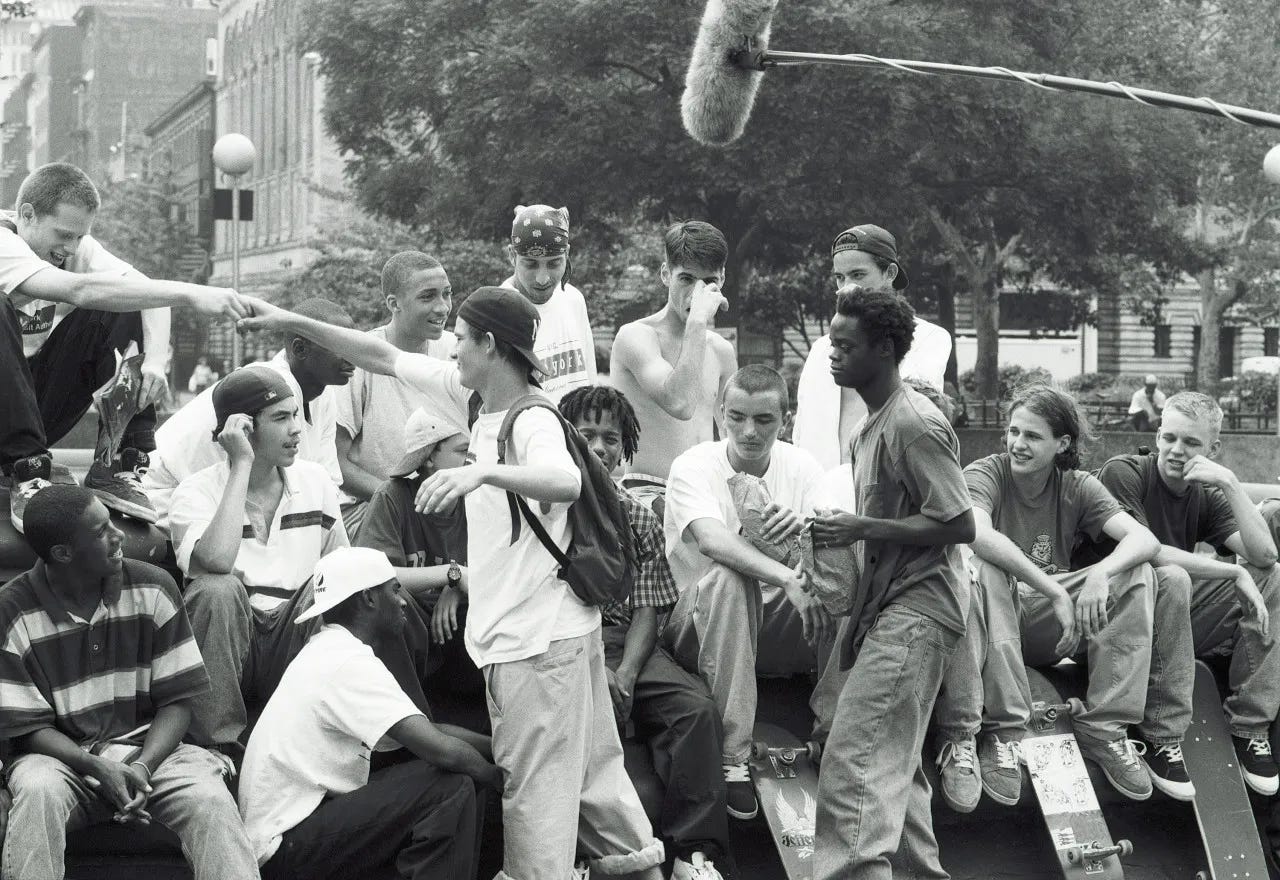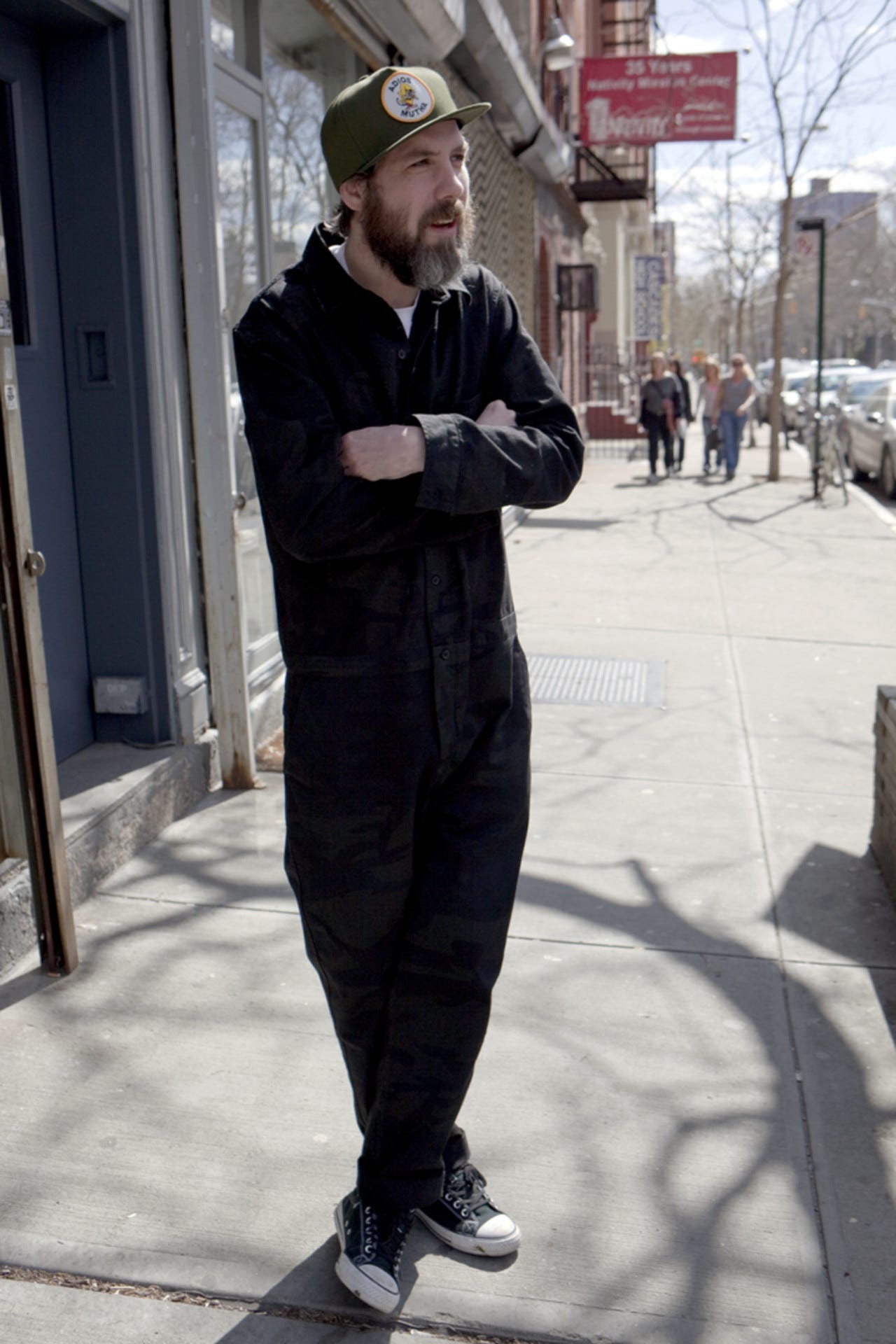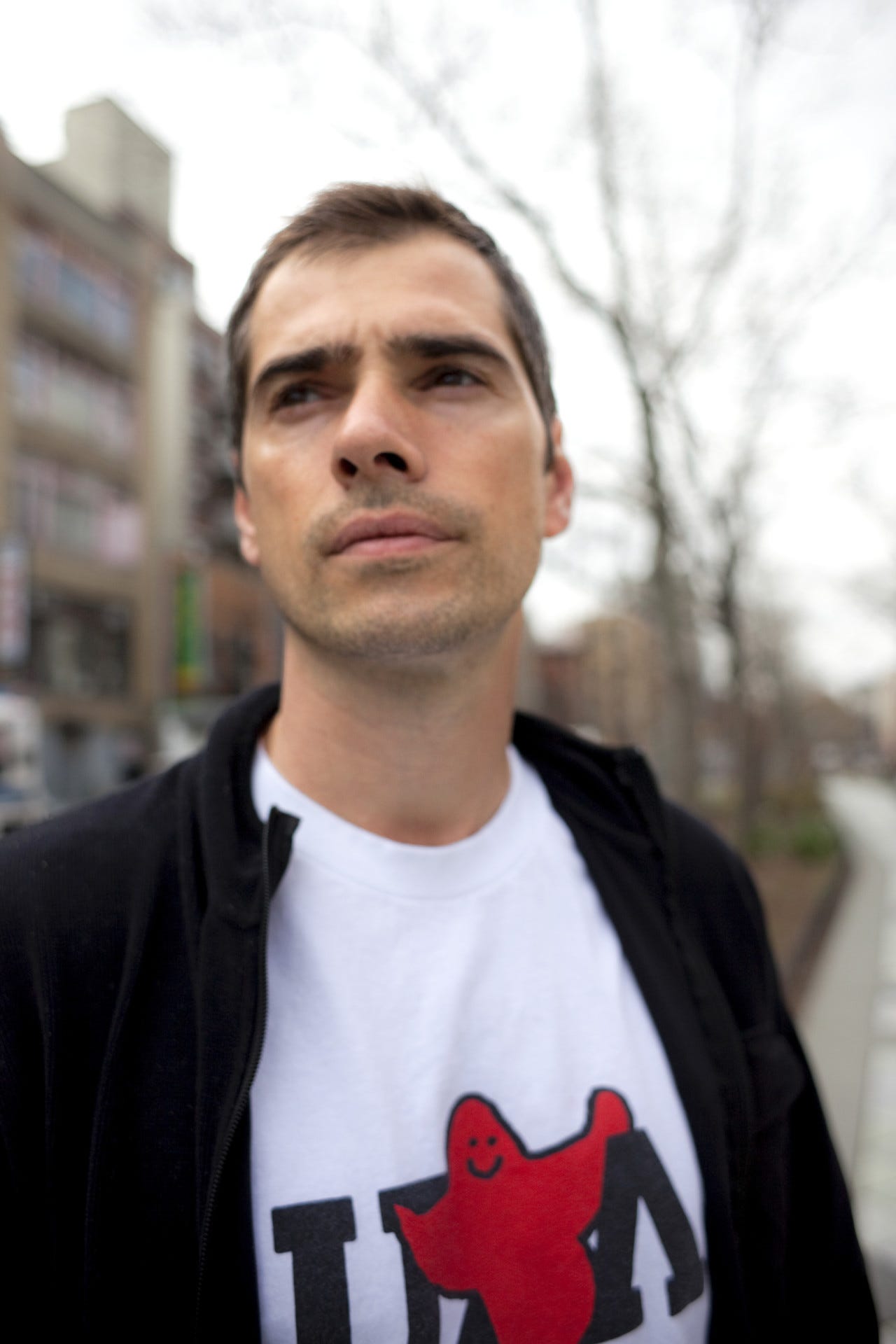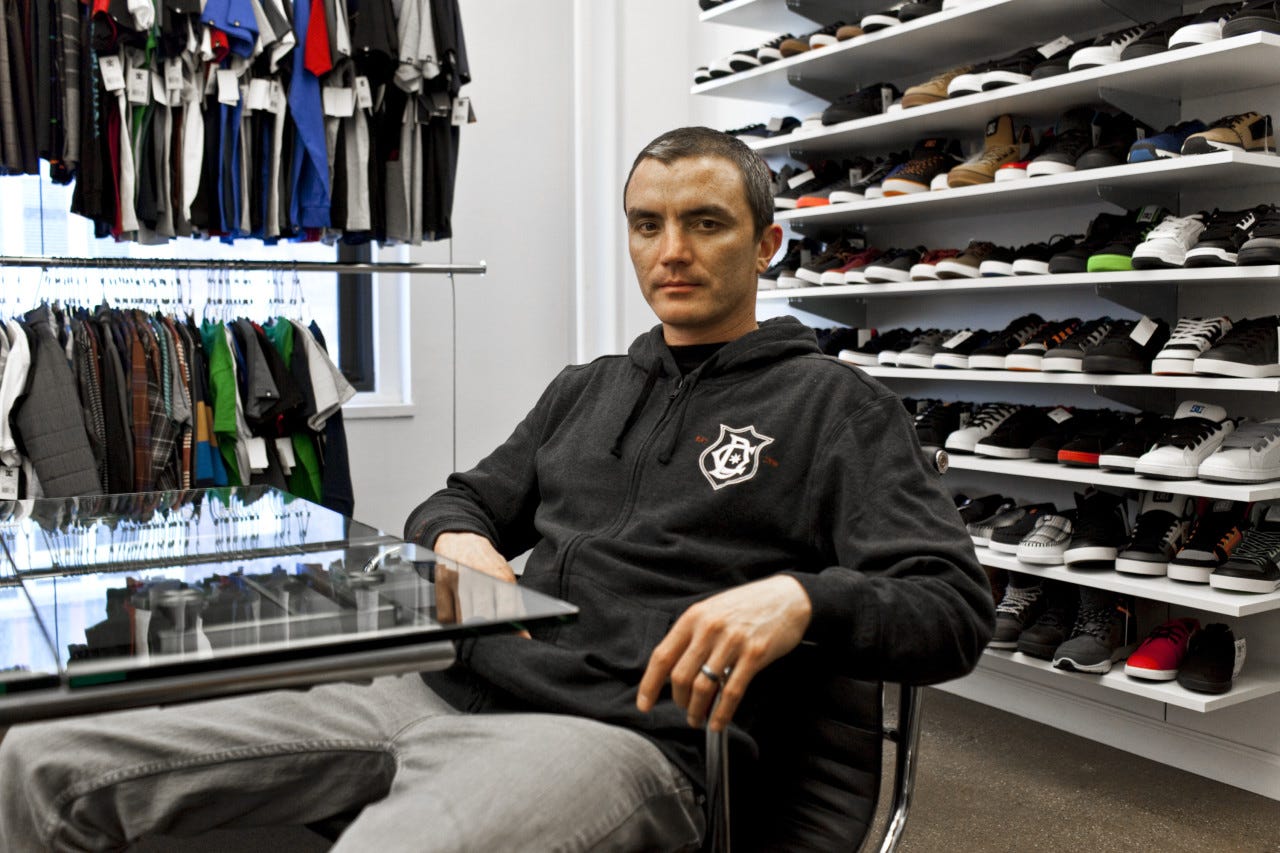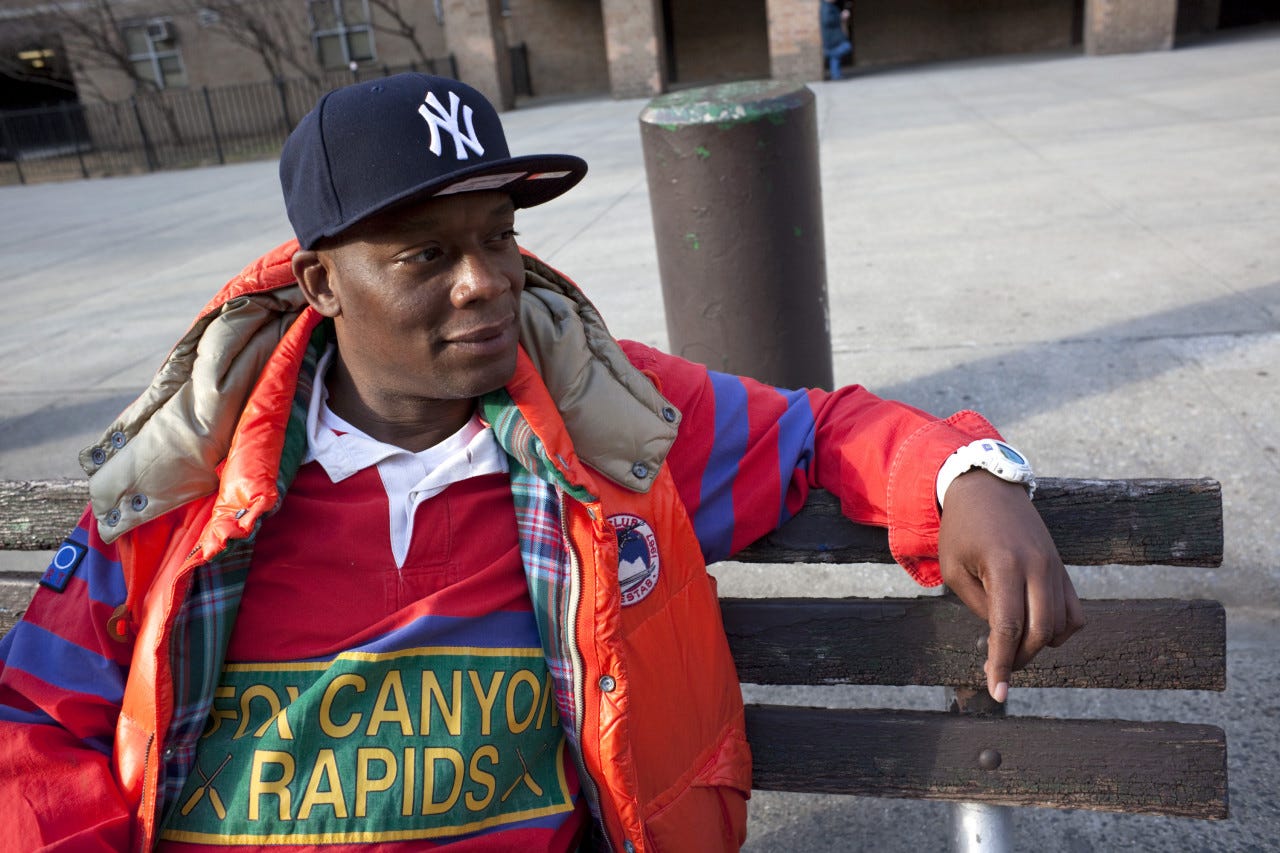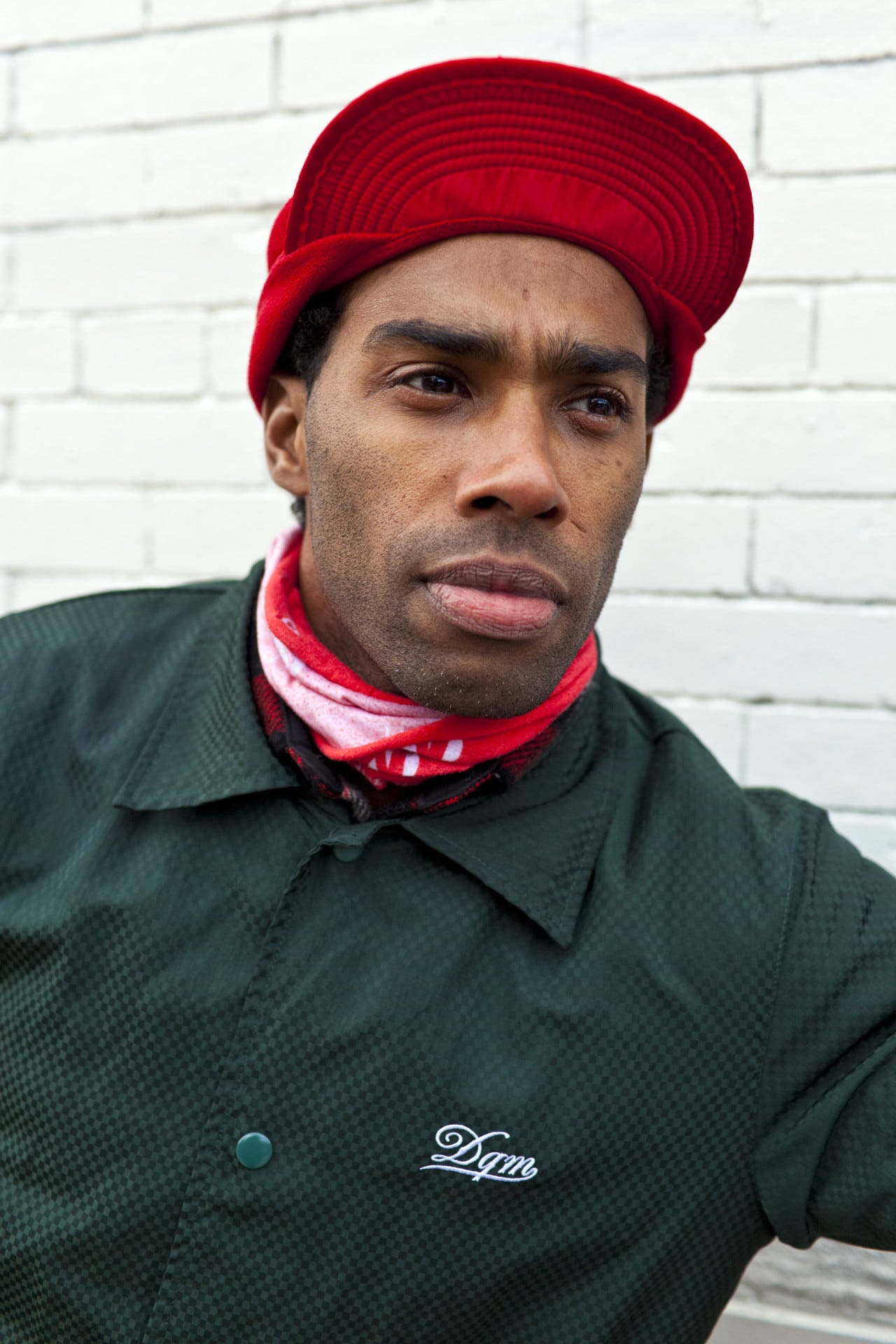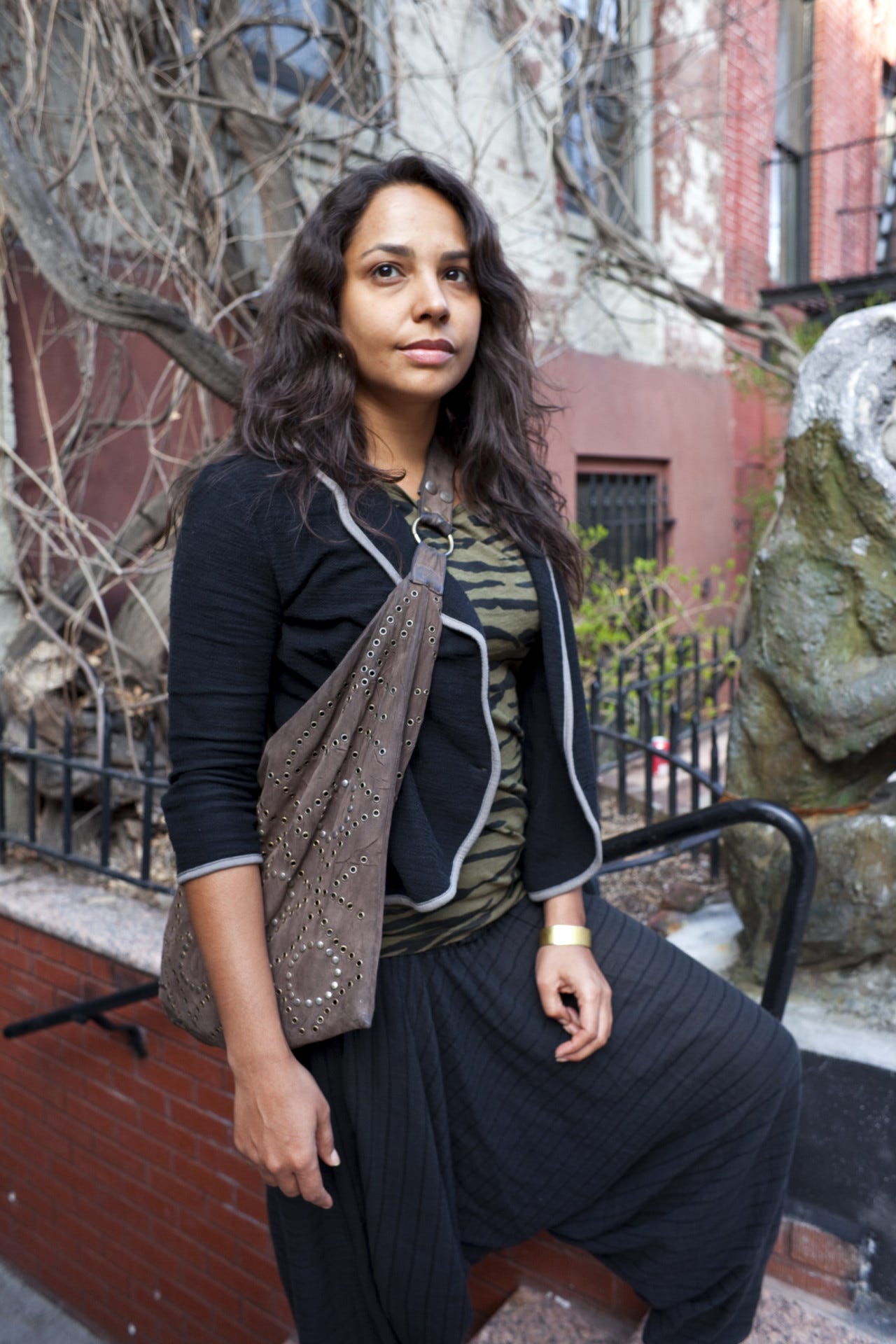Legends Never Die
Two decades after a low-budget film turned Washington Square skaters into celebrities, the kids from "Kids" struggle with lost lives and the fine art of growing up.
August 1990, St. Marks Place. Priscilla Forsyth, one month shy of her fourteenth birthday and just home from summer camp, straddles one of the two lion statues guarding the downward staircase to the apartment building her family has owned since 1975. Naturally blonde Liza and dyed blonde Margaret idle with her. It’s hot out, and Priscilla is becoming more curious about the world beyond her sidewalk.
An energetic kid with a scrawny but chiseled build named Harold Hunter rides up on his BMX bike. “I’ve never seen blonde people in New York” before, he tells the girls, giggling. He was from the Campos Plaza Housing Projects nearby–a different world, to be sure, although he’d obviously seen blonde girls before.
“That was his little excuse to start talking to us,” Priscilla recalls. “Harold was known for that.” The superlatives, the tall tales and jokes, the genuinely amicable first encounters–anyone who knew him knew that was Harold.
A month later, Priscilla and her friends were meandering downtown drinking forties, celebrating her birthday. They passed the Astor Place cube, a favored location for New York City’s premiere skateboard crew at the time. Priscilla and her girlfriends exchanged numbers with the skaters, and joined them the next day at the Brooklyn Banks, a world-renowned skateboarding mecca underneath the Manhattan side of the Brooklyn Bridge–that is, until the city shut it down a few years ago to use as storage space for bridge restoration.
When the girls arrived at the Banks, they met Harold and his friends, an infamous crew of amateur and professional skateboarders who rode alongside moving taxicabs and jumped off building and museum steps. Wherever they went throughout the city, the boys rode with a gutsy and fluid style. “It looked like art on a skateboard,” says Peter Bici, a skater and close friend of Harold’s. “It was a combination of New York City and the movement of streets and constant continuity of the city’s energy.” The kids loved each other like family, and didn’t give a shit about what anyone else thought of them. “We were minding our own business,” says Peter. “We don’t bother you. You don’t bother us. We all had each other’s backs.” It was an era when skateboarding wasn’t cool. If they heard wheels coming down the street, they’d run after them.
When Harold saw the girls, invited by his other friends, he made sure everyone knew he met them first. Priscilla says this now, twenty-three years later, imitating Harold in the nasal, raspy voice his loved ones mimic when telling Harold stories; the impersonation brings a comical lightness to the forefront, just like Harold always did.
Harold started regularly coming to the Forsyths’ for dinner. He became Priscilla’s surrogate brother. “Families didn’t adopt Harold, he adopted families,” says Priscilla’s sister Jessica.
Priscilla, now thirty-six, and Jessica, thirty-nine, with a black father from Grenada and a white mother from the Cleveland suburbs, went to the prestigious Hunter College Elementary and High Schools, commuting each weekday to the Upper East Side. But it was in the East Village where they met the skater crew, and Harold started bringing his friends over to the house too. Soon enough, the Forsyths’ apartment on St. Marks Place became another stomping ground, a clubhouse of sorts for this group of “lost boys.” Many, like Harold, hailed from broken homes.
When the 1995 film Kids, written by Harmony Korine and directed by Larry Clark, was released, Newsweek called it “astonishing”; Janet Maslin of the New York Times said it was "a wake-up call to the modern world." The Motion Picture Association of America initially branded the film with an NC-17 rating; upstart film producers Harvey and Bob Weinstein created a new distribution company to release it unrated into theaters.
In his July 28, 1995, review, the late Roger Ebert wrote, “Most kids are not like those in Kids, and never will be, I hope. But some are, and they represent a failure of home, school, church and society. They could have been raised in a zoo, educated only to the base instincts.”
The main character of Telly, played by Leo Fitzpatrick, is a scrawny, cocky kid on a perpetual hunt to seduce young New York City virgins; he and his sidekick Casper, a hyperactive foul-mouthed slice of authenticity played by Justin Pierce, traverse the city from sunup to sundown to complete their quest. Meanwhile, in an apartment somewhere, un-chaperoned teen girls wax poetic about sex. Two girls–Jennie, played by Chloë Sevigny, and Ruby, played by Rosario Dawson–go for AIDS tests; Jennie comes up HIV positive. She’s only had sex once, with Telly, and she sets out on her own hunt to find him. The boys meet up with their skater friends in Washington Square Park, some boys and girls break into a closed pool and go swimming, Jennie takes drugs at a nightclub, and they all end up at a house party where four little kids shoved side by side on a couch pass a joint back and forth. Telly screws his second virgin of the day just as Jennie arrives at the party to find Telly still inside his conquest. She passes out herself and is raped by Casper. The next morning, Casper wakes up naked on a couch and says directly to the camera, “Jesus Christ, what happened?”
Kids came from the minds of Korine, a skate kid from Tennessee whose grandmother lived in Queens and hung out with Harold and his friends, and Clark, already known for his gritty, sexualized youth photography. (Clark had started photographing the crew in the early 1990s.) It was the first film for both, and the camera barely leaves the kids, none of whom were actors at the time; all were plucked from Harold’s skater crew and elsewhere downtown.
Those of us who watched Kids as adolescents, growing up in an era before iPhones, Facebook, and Tiger Moms, had our minds blown from wherever we were watching–whether it was the Angelika Film Center on the Lower East Side or our parents’ Midwestern basements. We were captivated by the entirely unsupervised teens smoking blunts, drinking forties, hooking up, running amok and reckless through the New York City streets. Simultaneously, the driving storyline highlighted the terror of HIV and AIDS, which was at its apex in the mid-nineties.
Justin Pierce, who played Casper, took his life in July 2000, the first of several tragedies for the kids. Harold, who played himself in the film and is best remembered for swinging his dick around in the pool scene—he was that kid who wasn’t afraid, who radiated a magnetic and infectious energy both on and off screen—is gone too. He died in February 2006 from a drug-induced heart attack.
The film grossed millions and deeply impacted the lives and careers of all involved. Korine, who just released his newest film Spring Breakers, went on to artistic claim and fame. Clark continues making films and controversial photography, but Kids remains by far his most well-known project. Several kids went on to successful acting careers, most notably Chloë Sevigny and Rosario Dawson. Zoo York, the skate brand created in 1993 and home base for many in the crew, blew up overnight. New York skaters went from mini-celebrities in the extreme sport world to global notoriety; while on a Zoo York skate tour, Harold was recognized by film fans as far away as Japan.
In a coffee shop on the Lower East Side this spring, Peter Bici, a pro skateboarding legend who appeared in the film, tells me it’s not about him–the film, the interview, this article. Now a New York City fireman with a wife and daughter, Peter speaks with a thick, classic New York accent as tears well up in his eyes. “It’s about Harold and Justin,” he says. “I just want to keep Justin and Harold alive with these stories. It’s not about me, really. It’s not. It’s about them. That’s why I’m here. They still live on.”
The kids were a crew of about sixteen, maybe forty if the outer circle was around. The core clique was all in Kids, with roles ranging from starring to un-credited. Their surrogate parents were Rodney Smith, Eli Morgan Gesner and Adam Schatz, the then twenty-something founders of Zoo York. Previously, Rodney had founded SHUT, the first local brand to design boards that could withhold the blow of curbs, rails, and jumps to accommodate the changing face of New York skating. Zoo York’s Meatpacking District headquarters was their clubhouse, and Eli, a club promoter, was the crew’s link to New York nightlife—he developed the skating ramp inside the infamous Tunnel nightclub.

“We’d go to the Tunnel every Friday night or Saturday night,” says Jefferson Pang, forty-one, who is widely recognized as the first New York City skater to make it as a pro, and whose own Zoo York deck model was featured on the film’s poster, clutched by Harold. “It was crazy because there’d be a line down the entire street and we’d go up to the front with our skateboards and they’d just let us right in. It was insane.”
This was not California, and they skated everywhere in all sorts of harsh winter weather. They ollied over fallen trashcans, launched over sidewalk curbs, and jumped over cars. Every ledge was a right angle to master, every subway tunnel ramp was fair game.
“Our generation, we were the ones that really changed the whole game in skateboarding,” says Alex Corporan, forty. “A group of kids, black, white, Hispanic from every race, all together.”
“I was a black dude from the Bronx who listened to punk music as a result of skateboarding, but I come from a hip-hop background," says Mike Hernandez, now forty-two. “I was an anomaly. It wasn’t about color for us. Not at all. Our common ground was skateboarding and getting high. Kind of living for the moment, not looking about what’s coming around the corner.
“We came from fucked up backgrounds, you know what I mean?” he continues. “Straight up, like New York City kids. Our bond together was skateboarding. But skateboarding wasn’t cool. We were like a band of outsiders.”
“The way Kids happened,” says Jefferson, “it was all just kind of organic because Harmony was hanging out with us for years and he was just like some quirky kid from Nashville, Tennessee.”
Korine came to New York to attend New York University’s Tisch School of the Arts for film, living for a time at Harold’s apartment in the projects—the two had met while Harold was skateboarding in Tennessee—before moving to his grandmother’s home in Queens. Harold was his introduction to the crew.
Then, one day, after both Korine and Clark had been hanging around the kids, “Harmony’s like, ‘We’re going to be making a movie together,’” says Jefferson. “And then he was like, ‘It’s gonna’ be about you guys.’ I was like, ‘What? Who’s gonna’ watch a movie about us?’”
“Harmony didn’t create this mysterious subculture of skateboarders in New York City,” says Jefferson. “That was our lives. Minus the whole virgin hunter part of it.” Telly’s virgin hunter character, popping cherries from morning to night, was hyperbolized for the film, fictional material Korine added to make it more "Hollywood." “[Harmony] was kind of there when we were hanging out at Washington Square Park or Astor,” says Jefferson, but he doesn’t recall him joining them on “skate missions.”
There is some debate over how perfectly Korine and Clark captured the kids’ lives. Hamilton Harris, a music producer and writer, whose hands and lips became the close-up montage of a blunt-rolling tutorial in the film’s infamous Washington Square Park scene says, “Kids was an outside perspective because the author is not Hamilton, or Peter Bici, or Justin, or Harold. So it’s told from the outside. As the years went on, [the film] became the catalyst for the skater who’s grungy, who’s got problems at home. What was never explained, in my opinion, is what creates that.”
Korine, nineteen at the time, and Clark, then over fifty, wrangled the troops from the skate clique, supplementing them with more non-actors from Washington Square Park and the club scene, and across downtown—including Chloë Sevigny, from tony Darien, Connecticut, who had been hanging out with the crew in Washington Square Park for years. They plucked a then fifteen-year-old Rosario Dawson from her stoop in the East Village. Vibe magazine was shooting a commercial on her block, and her father told her to go downstairs to get discovered. Korine heard her laughing loudly at a strange man who looked like Jesus, walked over and told her, “You’re exactly what I wrote.”
Rosario’s father rode her on his bike handlebars to the auditions, downtown on Broadway. When it came down to Rosario and another girl for the part of Ruby, Harold, who she knew from the East Village, was the deciding factor–he told Korine and Clark to go with his neighbor.
Jon “Jonny Boy” Abrahams, a club kid from TriBeCa, was originally cast as a random guy in the club scene making out with two girls. Then, while at a summer program in Vermont, Jonny got a call from Clark. A bigger part had opened up–Steven Cales, a member of the skater crew who was scripted to play himself, had been arrested for armed robbery.
“We were kind of harsh on [Jonny] because we knew it was supposed to be Steven,” says Jefferson. “Because then Harold, Justin, and Steven would have been the big guys in the movie.”
“Most of the kids in the movie were the skater kids,” Jonny says. “Everybody knows each other, because it’s a pretty small community of kids back then in downtown Manhattan. I wasn’t like best friends with these guys at all. I think that they were a little pissed off that, like, 'who’s this fucking club kid that got our friend’s part now that he went to jail'? I definitely had to work for their affection, a little bit.”
And of course, Harold was his "in," because Harold was everyone’s in. “Harold Hunter was the diplomat of downtown,” says Jonny. “He was able to navigate through all those cliques and make connections that way, which wasn’t an easy thing to do in that age.”
“Harold, he was seriously the one connector to everybody,” says Leo Fitzpatrick, the skater who portrayed Telly. “He really never judged anybody. He didn’t give a shit where you were from, what you looked like. He was like an ambassador for New York skateboarding.”
Harold even taught his own family to look beyond race, says his brother Ronald Hunter, who notes that Justin was the first white guy Harold ever brought home to the projects. “That’s why I love my brother,” says Ronald. “He taught me a lot about diversifying.”
Kids filmed in the summer of 1994. “None of us knew what the fuck we were doing,” Jonny says. “Like, none of us understood continuity in film or any of that stuff. Anytime they cut we would just walk off and smoke weed and drink forties.”
Justin, who lived with Jefferson on the Upper West Side during filming, was a good-looking skater kid from a rough home with a massive spirit, an explosive personality and an ability to get a little reckless when drunk. Jefferson made sure Justin showed up on set every day.
“I think at the end of the day, this was more like summer camp than making a film for a lot of us,” says Leo. As an outsider from New Jersey, Leo didn’t fully mesh with everyone immediately. “I was kind of more like a narc,” he says. “Where they’re like, ‘How the fuck did this guy get in?’”
The Forsyths’ apartment building was part of the set, as a stand-in for Telly’s house, and while Jessica didn’t want to be on camera, Priscilla was one of the girls at the beginning jabbering about sex and boys. Everyone else who was “in” appeared in the notorious Washington Square Park scene, sitting side-by-side in a massive clump, skateboards in hand. In that scene, Casper, played by Justin, skates off and accidentally knocks a bystander, credited as “Hoodlum.” Casper apologizes, the Hoodlum says, “Watch where the fuck you skatin’ at.” A scuffle ensues, Harold runs over and hits Hoodlum on the head with a skateboard, the other kids catapult from the fountain ledge, and everyone beats the shit out of Hoodlum. To punctuate the massacre, Casper swings the bottom of a skateboard into Hoodlum’s face as a shirtless Peter Bici holds him up, Hoodlum’s mouth gapping open with head cocked forward, eyes shut. Telly hocks a loogie, spits it onto Hoodlum’s left temple, and Casper leans down to say, “Now get in my way, bitch!” The crew cackles; adults cringed.
The kids say the film was accurate, except for the most fantastical stuff. There’s no denying they weren’t sober during filming. Even the scene with Javier Nunez, at fourteen, by far the youngest of the skate crew, and three other little kids mashed on a couch smoking a joint and pontificating about god and life—that too was real. The virgin hunter, the AIDS plotline, and the rape scene at the end were fictional.
“But overall, that’s exactly what it was like,” says Jonny. “You ran around the fucking streets of New York. The city was just crazy at that time and things were different with kids. It’s certainly not like that anymore. I think that Kids is probably, to me, the last time you see New York City for what it was on film. That is to me a seminal moment in New York history because right after that came the complete gentrification of Manhattan.”
Kids immortalizes a moment in New York City when worlds collided–“the end of lawless New York,” Eli says–before skateboarding was hip, before Giuliani cleaned up, suited up, and wealthy-ed up Manhattan.
“I don’t think anyone else could have ever made that movie,” says Leo. “If you made that movie a year before or after it was made, it wouldn’t be the same movie. Everything just clicked in a very kind of natural way.”
“It’s almost like Kids was the dying breath of the old New York,” says Jessica.
“None of us had any idea what was gonna happen with this movie,” says Jonny. The film screened at the 1995 Cannes Film Festival and at Sundance, and Justin Pierce won an Independent Spirit Award for best debut performance. Chloë went on to a wildly successful film career, including an Academy Award nomination, and Rosario Dawson has built a successful Hollywood career as well. Jonny has acted in dozens of films and television shows and also DJs in Los Angeles.
“This movie literally changed the course of my life,” Rosario said.
Yet, while the film became a rite of passage for all of us outsiders watching with dropped jaws across the country, not everyone on the inside felt the same.
“I remember shortly after that, they had a screening for all of us–everybody that was in it–and, like, I thought it was the worst movie I ever saw,” says Jonny. “Everyone seems like they’re acting and it just seems really bad. It had no effect on me whatsoever.”
“I didn’t watch the movie for five years,” Jonny says. “And then one night it was on television, and I watched it. By the end I was, like, almost in tears. Like, it affected me so much. I don’t know if it’s because I had to grow a little bit and gain a little bit more of an adult perspective on how wild it was to be a kid then or what, but like, it’s a powerful, powerful, powerful movie. They don’t make movies like that very often.”
If it was surreal to see themselves on screen, exposed to the rest of the world, for Leo it was “kind of traumatic.” He just wanted to keep being a skater; now he was something else. He moved to London, where he could be anonymous, and then Los Angeles, doing odd jobs, refusing to act despite industry efforts to help him capitalize on his Kids acclaim. He moved back to New York at twenty-one and eventually started acting again, though he didn’t comfortably settle in to the profession until his recurring role on The Wire in the early 2000s. “I had to grow up and find a level of comfort within myself to say that acting isn’t so lame,” he says.
“The things that I was seeing on the outside manifest after the movie Kids–it made me introvert,” says Hamilton. “I knew I wasn’t ready to do things at the time Justin did or at the time Harold did.”
More than anyone else from the skate clique, the film thrust Harold and Justin into the Hollywood spotlight, and the duo was hungry for fame and eager to act. Justin moved to Los Angeles and devoted himself to acting while still skating as a hobby. Harold skated professionally and toured the world with Zoo York, alongside Peter and Jefferson and several more of the kids, but took full advantage of his movie fame. People recognized him worldwide, and when they didn’t, “Yo, you ever see that movie Kids?” became his signature line.
“Everybody wanted a piece of him,” says Jessica. “Everyone wanted to claim him as their own.”
Before Kids, it always took ages to walk anywhere with Harold around New York City. He knew everybody—from grandmothers to punk rockers to squatters and beyond, but the movie took it to new heights. “People liked my brother before Kids,” says Ronald. “After Kids, it just got worse. It just got so ridiculous.”
Harold grew up with Ronald and younger brother Michael in the Campos Plaza Housing Projects. Their mother passed away when they were kids. Their grandmother raised them until she passed when Ronald was sixteen, and he assumed guardianship of his brothers.
On an April afternoon this year, Ronald sat on a bench in the middle of the housing project wearing a Yankee’s cap with a barcode sticker underneath the rim, high top loafers, khakis, a red collared jersey shirt with blue stripes and a thick, orange vest with a hood. His six-year-old son sat wide-eyed and patient to his right. Ronald pointed to their apartment–fifth floor, front of the building, with several fabrics and blankets hanging out of the window.
Ronald, his wife, and their two kids—the six-year-old and a four-year-old daughter—live in Elmhurst, Queens, and Ronald works as a technician for an insurance company. They moved out of the East Village shortly after Ronald found Harold dead in their home. “I come back here when I feel homesick,” he says.
Priscilla says Harold didn’t drink or smoke pot extensively growing up–the joke was that he didn’t need to because he was so naturally high. “But after the movie came out, then he started partying with all kinds of people,” she says. “I guess that’s what people want from you and they want to hang out with you and they buy you drinks and they give you drugs. And I think also there’s an element of insecurity that came along with the awesome feeling of being loved and I can only imagine that he needed it more.”
Harold, while in a handful of other films, kept skating professionally for Zoo York and touring worldwide, which contributed to his burgeoning fame from Kids. He remained intrinsically tight with the clique, and of course Justin. Harold loved Justin, and would visit him out in L.A. In the five years following Kids, Justin always seemed to be on the precipice of something big, appearing in over a dozen films and TV shows, but his success was supplemented by a lust for partying. In the summer of 2000, Alex visited to join him at the premiere of the film King of the Jungle. While his acting career was beginning to boost, Justin had been coping with personal problems. A week later, Justin flew to Las Vegas for a streetwear convention. He killed himself in his hotel room.
It is viscerally clear how much Justin’s death impacted the crew. “The fact that it was a suicide is such a difficult thing to deal with,” says Priscilla, who, while a teacher in Compton, lived across the street from Justin and his wife in Los Angeles. “Justin was an amazingly wonderful person, but he also suffered from a lot of emotional pain in his life.”
A year later, over the July 4th holiday in 2001, the crew experienced another loss: Keenan Milton, who had moved to Los Angeles as a pro-skater before Kids, but remained part of the family. Keenan accidentally drowned in a pool at a party. The back-to-back deaths devastated the clique; Justin’s especially was a particular blow to Harold.
“Harold was loving and wanted to make people happy. But he also was frustrated and angry and upset,” says Jessica. “And insecure and all of the range of emotions.”
“[Harold’s] like a brother to me,” says Jefferson. “We’d always be fighting, but I would kill someone for him. We’ve traveled the world together and it’s always been like I kind of have to be his handler and bring him down to reality and put him in check because he always wanted to have as much fun as possible. And it was always at his expense. He was never conscious of anything he was putting in his body. The way he ate, or his lifestyle. But that was the thing about Harold, he was such a free spirit. He lived every moment to the fullest. To the last day, he was still being Harold. We always were concerned: what’s Harold gonna’ be like as an adult? Even though when he passed away he was technically an adult, he was still being Harold.”
Ronald says towards the end, Harold was preoccupied with how fame and notoriety affected him. “It’s like a sponge that won’t expand even if you soak it in water,” he says. It wasn’t just partying. His life didn’t only belong to him. Isn’t that what we always do to celebrities?
“He was insecure. And he was jealous,” says Priscilla. “And he struggled just like everybody struggles with emotions. Sometimes he handled it well, and sometimes he did not handle it so well. He was a human, he was definitely not a saint. I think that's important.”
Jefferson, Priscilla, Ronald, and others who knew Harold, switch between past and present tense when talking about him, as if he’s still here, as if no one will ever say goodbye.
It was the final, gut-wrenching blow for everyone, the third in a horrific series of tragedies, of lost boys completely lost. Less than twenty-four hours after seeing many of his skateboarding brethren at an event where everyone remembers him smiling, full of life, Harold was dead.
“It was hard to say goodbye,” says Priscilla. “It was also just so impossible to accept.”
There was a three-day wake, followed by a Saturday funeral. Hundreds from myriad walks of life came to pay homage to a downtown legend. His casket was on skateboards. “It’s like we were burying a rock star, pretty much,” says Alex.
“I’ve never been to a funeral like the one I saw of his,” says Rosario. “Three days of people coming from all around the world…I hope that he felt all that love we all showed in his passing.”
“There was this little kid,” remembers Peter. “He was young. Must have been like ten or eleven years old. This Spanish kid. And he had a skateboard. He was crying. I said, ‘Why you crying, bro?’ He’s like, ‘I’m gonna miss Harold.’” Peter starts tearing up, crying himself, now whispering. “He says, ‘I’m gonna miss Harold.’ This kid’s fucking ten years old. To affect a ten-year-old kid. To be nice to a ten-year-old kid?
“It’s tough. I love the guy. I miss him very much.”
Peter says it was “a real wake-up call” when guys started dying. Everyone uses the same term, “wake-up call,” as if the term is inherent to Harold and Justin reveries. Rosario says it’s still a wake-up call; it caused Mike to look deeply inside himself and reevaluate his life. The way Kids was a wake up call for teenagers nationwide regarding drugs and sex and AIDS, these deaths–of the real kids– awakened the community, no matter how difficult it still is to think about.
Every time one of the guys starts to talk about Justin or Harold, it’s as if they have to fast forward to the moment they can laugh, the moment of comic release, the moment after the phone calls telling of tragedy and the funerals and memorials. Everyone is hesitant to speak about both deaths, especially Justin’s, but they’ll talk for hours about how funny and kind and giving Harold was.
“Harold wanted to make people happy,” says Priscilla. “That’s part of why he makes all the jokes is cause he wants to make people laugh, he wants to make people happy, he wants to give people what they want.”
“He was brilliant. He loved. He gave,” says Rosario. “I think about Justin. I think about Harold often. It reminds me to be grateful. To be present to a lot of the amazing things. It all keeps changing. And who knows what it can all change into it. It happens very quickly.”
“After he passed away, New York wasn’t the same,” Peter says. “You go out with Harold, Harold would make you laugh. There wasn’t one time when we went out when we did not have a sincere laugh together. So I lost that. And Justin was different. Justin was more quiet. He had the heart of a lion. He wasn’t scared of nobody. He was a small guy. He wasn’t a big dude. But he wasn’t scared of nobody. They each had their own thing that was beautiful about them.”
“You think about Kids, you think about Casper and Harold,” says Peter. “Right? You think about Harold swinging his dick in the pool. You think about crazy-ass Casper with the forty.”
“In a fucked-up way, Kids contributed to Harold dying and Justin dying because you gotta’ realize, these are kids from fucked-up backgrounds,” Mike says. “And a person like Harold–a quintessential clown, like twenty-four-seven ‘The Harold Show,’ and everyone that was around him, like laughing–you couldn’t turn him off.”
“Granted, there’s going to be causalities,” Mike continues. “I know this. But obviously, there’s nothing that we could have done to prevent it. We weren’t supposed to be each other’s guidance counselors or social workers. We were there for each other, through skateboarding, but we kind of had to muddle through our own issues and demons on our own. We were in the water together swimming. But there wasn’t a life raft. So, eventually, we kind of had to learn to swim well, breaststroke, sidestroke, or whatever, to try to get to the mainland. Try to find a ship, whatever the case may be. Some niggas didn’t realize how they could swim so they just fucking drowned. Some niggas found land, some niggas found a ship.”
Jessica Forsyth holds a PhD in counseling psychology and is a postdoctoral fellow at New York University’s School of Medicine. In her spare time she volunteers as director of programs for the Harold Hunter Foundation, which she, her sister, and several other friends founded within months of Harold’s death. Jessica smiles often, gently, and speaks with an aware patience.
The Foundation’s mission is to “use skateboarding as a vehicle to provide inner-city youth with valuable life experiences that nurture individual creativity, resourcefulness and the development of life skills.” In addition, Jessica says they’re “trying to provide some sort of support for New York City skateboarders, I mean, really so that nobody has to end up like Justin or Harold…or Keenan.”
She remembers thinking, as early as Justin’s funeral, “somebody needs to save these kids.”
“The kids who are skaters today, they have some similarities to those guys,” she says. “These kids are nowhere near as rough in terms of what they’re dealing with. They’re not sort of skaters by necessity. It’s by choice. But I also think there’s something about skateboarding as a community that really does take care of each other and teach kids to be sort of entrepreneurial and independent. That’s really the same as it always has been. Skateboarding was so amazing for Harold and we wanted to bring these kinds of opportunities to kids like Harold.”
The sparse Harold Hunter Foundation office is in an apartment in the Forsyths’ building on St. Marks Place–a loft bed, a vacant kitchen, a gorgeous view of a sprawling backyard, a coat rack, a tiled bathroom, a framed Kids poster leaning against the wall, and a desk from which Jessica manages the organization.
The Foundation sends kids to Woodward, a residential action sports camp in Pennsylvania where Harold had gone and loved as “heaven on earth,” says Jessica, returning as a professional skateboarder to work with kids. This past winter, they sent a handful of young skaters to the Dominican Republic on tour. Foundation intern Wade Yates, twenty-three, says he was deeply touched by all of the skateboarding youth they met in the DR. “I mean, the whole country needs help, but definitely the skaters are hurting a lot,” he says.
“I think it’s amazing what we have been able to accomplish given what little we have and how hard it is to get anything done,” says Priscilla, a board member. “So that’s really exciting and good. I feel like Harold's legacy deserves even more and is worthy of so much more. And I just hope that we can keep this thing alive long enough to the day where it can really be something big.”
Despite the tragedies, the rest of the kids, now adults, remain deeply impacted by their experience making the film.
“It definitely changed my life,” Leo says. “I’m sure everybody will say that.” Leo still acts, most recently in The Heart, She Holler, but skipped Sundance earlier this year–even though he was in two festival films–to attend an art fair in Los Angeles. He spends weekends at his art gallery, Home Alone 2. He has no desire for fame, and hopes to make a solid living as an obscure actor. “It took my whole life to figure out why I’m acting,” he says. “That is what from Kids to today was all about.”
In 2001, Zoo York partnered with Eckō unltd, the very successful urban lifestyle clothing company. Eli and Adam stayed on as consultants for a few years, but by 2005, they were all gone, and the crew’s original “surrogate parents” came back together to relaunch SHUT Skates and pay homage to the New York City skateboarding history they helped create.
After skating professionally for the original Zoo York team and becoming team manager in the late 90s and early 2000s, Jefferson is now the sales director for skateboarding at DC Shoes. He has a wife and two kids. He doesn’t skate much anymore, or go out and meet the boys.
“As a father now, to think about what we were doing during that film, and my kids doing that at that age–I would lose my mind,” says Jefferson. “But to us, at that time in New York City, it was completely normal. Now, young kids are so much more sheltered. We’re in a different time.”
“I loved all my skater friends, I loved these guys,” says Mike, who now works as a New York City fireman. “These guys were my family. And the city was our fucking playground.”
“It’s different,” says Peter, speaking of his own life as a fireman. “It’s different,” he repeats two more times, with a slow, steady, vulnerable decrescendo. “I have new friends now.” Pause. “But, the bond that we had back then will never be the same as, I don’t know, anything I’ll probably experience.” Another pause. “It’s just different. We have each other’s backs at work. But it’s a different feeling. We had more in common back then. We were all the outcasts looking out for each other.”
“The movie itself doesn’t really mean much to me,” says Priscilla. “But I still do think the experience itself was a pretty remarkable experience for us to have. I find it more kind of fascinating that anyone cared about it. I can get it to some degree, but it is difficult to think of it as something more than just us being silly. Us sort of melodramatically being ourselves.” She laughs.
On Harold Hunter’s birthday, April 2, over a dozen people post variations of the phrase “Legends Never Die” on Harold’s Facebook wall (an account Jessica maintains), with a total of fifty-five comments, 422 likes and twenty-three shares. At a Soho bar that afternoon, Alex tells me the phrase is something Harold used to say all the time.
“About himself?” I ask.
“Yeah,” Alex says with a huge smile.
“He would always say that,” says Priscilla. “But he would also say, ‘Keenan is a legend. Justin is a legend.’ It was about the people he loved.”
“Harold made everyone feel like their best friend within ten seconds,” Alex says. “That was what was special about Harold. Like everyone, all around the world. You ask everyone, they’re like, ‘oh, Harold’s my best friend.’ They probably hung out with him for a week. That’s the kind of energy Harold had. There’s never gonna’ be anyone in the world that could ever do that again. At least in my living presence there won’t be anyone like Harold.”
“It was meeting Harold in front of my house when I was thirteen and becoming very close friends with him and him essentially becoming part of our family, that was my first real glimpse into how different growing up in poverty was, particularly in terms of educational opportunities,” says Priscilla, who has dark curly hair, thick tortoiseshell glasses, and glistening skin. She works full-time for a non-profit organization working towards educational equity.
Priscilla observed life through a particular lens growing up biracial, especially with regard to Harold. “He grew up about five or six blocks away from me,” she says. “We had similar interests, similar senses of humor, liked to do the same things. But because my mom made it her business to try to find us the best possible school in the city and we traveled far outside of our neighborhood to go, I experienced something very different than he did.”
Harold directly inspired her career, including her application to the teaching job in Compton. “I have a hard time imagining who I would be if it weren’t for Harold,” she says.
Priscilla, her husband, and their two children live in the top apartment of the family’s building. Photographs of Harold line the molding of the walls, inching up to the ceiling. Her children’s drawings are spread across the kitchen table, and she holds several thin Crayola markers while she shares stories about growing up with the kids and her memories of Justin and Harold.
While leaving her apartment, I can hear the television from her parents’ apartment downstairs. Generations stacked upon generations with a legacy of a lost boy lingering in the middle, a clubhouse holding on to a moment in time, a kitchen that was once a movie set. Outside, the two lion statues are fading into something amorphous. A tree winds up the side of the building–rooted, but growing upwards.
The sound of small wheels pound against the adjacent sidewalk. “Still to this day when I hear someone skating down the street,” says Rosario, “I turn around because I think it’s Harold.”
I twist my head. It’s a woman dragging a rolling suitcase.
No skateboard. No grip tape. No lost boys. The kids are all grown up now. Two are immortalized, deeply missed, profoundly loved, and gone far too soon; though their laughter no longer ricochets through the streets of New York City, they, too, have been found.
Liked this story? Our editors did too, voting it one of our 20 best untold tales! See the complete list of Editors’ Picks here.
Read the behind-the-scenes piece about lost sleep, 76 pages of notes and meeting the Kids kids heart-to-heart.
Caroline Rothstein is an internationally touring writer, poet, performer and educator. Her work has appeared in Cosmopolitan, Marie Claire, The Guardian, BuzzFeed, Nylon, The Forward, Hey Alma and elsewhere. She speaks, performs poetry and teaches at colleges, summer camps, and performance venues worldwide and virtually.
Jonathan Weiskopf is a visual artist living in Brooklyn. His first book, For Some Time Now: Performance Poets of New York City, was self-published in April 2012. Find him on Twitter @jsweiskopf.
Brendan Spiegel is the editorial director and co-founder of Narratively.


